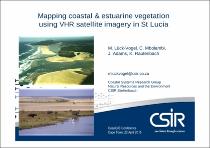JavaScript is disabled for your browser. Some features of this site may not work without it.
- ResearchSpace
- →
- Research Publications/Outputs
- →
- Conference Publications
- →
- View Item
| dc.contributor.author |
Lück-Vogel, Melanie

|
|
| dc.contributor.author |
Mbolambi, C

|
|
| dc.contributor.author |
Adams, J

|
|
| dc.contributor.author |
Rautenbach, K

|
|
| dc.date.accessioned | 2017-07-28T09:36:35Z | |
| dc.date.available | 2017-07-28T09:36:35Z | |
| dc.date.issued | 2015-04 | |
| dc.identifier.citation | Lück-Vogel, M., Mbolambi, C., Adams, J. et al. 2015. Mapping coastal & estuarine vegetation using VHR satellite imagery in St Lucia. International CoastGIS Symposium Proceedings, Cape Town, 22 April 2015 | en_US |
| dc.identifier.uri | http://hdl.handle.net/10204/9402 | |
| dc.description | International CoastGIS Symposium Proceedings, Cape Town, 22 April 2015 | en_US |
| dc.description.abstract | The iSimangaliso Wetland Park in which the St Lucia estuary is embedded hosts the largest estuarine system in Africa (155 000 Ha). Remote sensing mapping of the composition of the otherwise largely inaccessible estuarine vegetation provides a baseline for understanding and managing of estuarine environments. Within the presented project, we compared ecosystem and land cover classifications for the Greater St Lucia region derived from very high resolution (VHR) multispectral imagery from the RapidEye, WorldView-2 and SPOT-6 sensors with and without the additional use of LiDAR derived topographic data. As ground reference, a GIS-derived wetland classification based on site visits and aerial photos have been used. Results show that accuracies increase with higher spatial resolution, of both, the multispectral as well as the Li-DAR derived topographic data. | en_US |
| dc.language.iso | en | en_US |
| dc.relation.ispartofseries | Worklist;19149 | |
| dc.subject | St Lucia | en_US |
| dc.subject | Vegetation mapping | en_US |
| dc.subject | Remote sensing | en_US |
| dc.subject | LIDAR | en_US |
| dc.title | Mapping coastal & estuarine vegetation using VHR satellite imagery in St Lucia | en_US |
| dc.type | Conference Presentation | en_US |
| dc.identifier.apacitation | Lück-Vogel, M., Mbolambi, C., Adams, J., & Rautenbach, K. (2015). Mapping coastal & estuarine vegetation using VHR satellite imagery in St Lucia. http://hdl.handle.net/10204/9402 | en_ZA |
| dc.identifier.chicagocitation | Lück-Vogel, Melanie, C Mbolambi, J Adams, and K Rautenbach. "Mapping coastal & estuarine vegetation using VHR satellite imagery in St Lucia." (2015): http://hdl.handle.net/10204/9402 | en_ZA |
| dc.identifier.vancouvercitation | Lück-Vogel M, Mbolambi C, Adams J, Rautenbach K, Mapping coastal & estuarine vegetation using VHR satellite imagery in St Lucia; 2015. http://hdl.handle.net/10204/9402 . | en_ZA |
| dc.identifier.ris | TY - Conference Presentation AU - Lück-Vogel, Melanie AU - Mbolambi, C AU - Adams, J AU - Rautenbach, K AB - The iSimangaliso Wetland Park in which the St Lucia estuary is embedded hosts the largest estuarine system in Africa (155 000 Ha). Remote sensing mapping of the composition of the otherwise largely inaccessible estuarine vegetation provides a baseline for understanding and managing of estuarine environments. Within the presented project, we compared ecosystem and land cover classifications for the Greater St Lucia region derived from very high resolution (VHR) multispectral imagery from the RapidEye, WorldView-2 and SPOT-6 sensors with and without the additional use of LiDAR derived topographic data. As ground reference, a GIS-derived wetland classification based on site visits and aerial photos have been used. Results show that accuracies increase with higher spatial resolution, of both, the multispectral as well as the Li-DAR derived topographic data. DA - 2015-04 DB - ResearchSpace DP - CSIR KW - St Lucia KW - Vegetation mapping KW - Remote sensing KW - LIDAR LK - https://researchspace.csir.co.za PY - 2015 T1 - Mapping coastal & estuarine vegetation using VHR satellite imagery in St Lucia TI - Mapping coastal & estuarine vegetation using VHR satellite imagery in St Lucia UR - http://hdl.handle.net/10204/9402 ER - | en_ZA |






